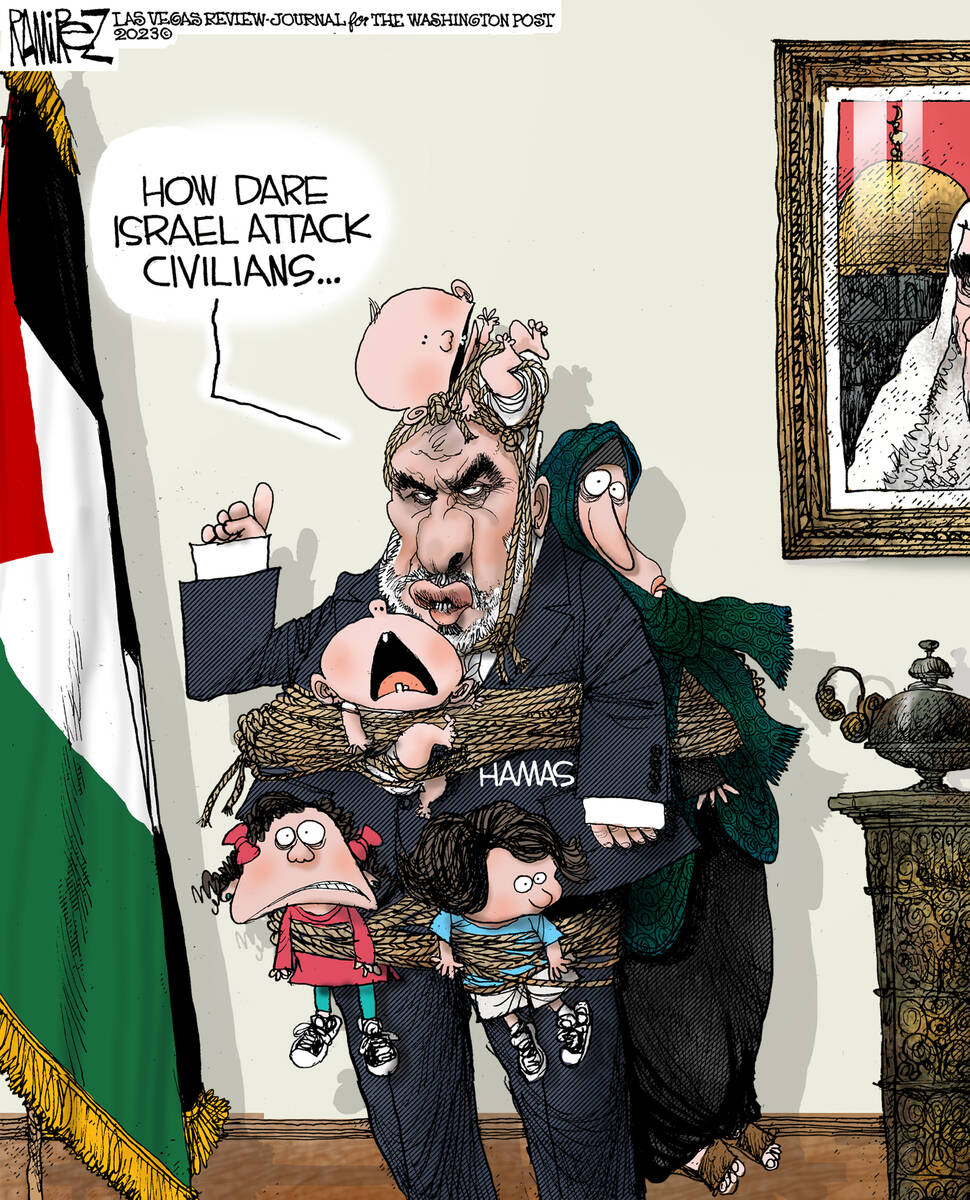MICHAEL RAMIREZ: In defense of editorial cartooning
In an interview on Lebanese television, senior Hamas official Ghazi Hamad hailed the brutal Oct. 7 attack and the systematic murder, torture and kidnapping of unarmed men, women and children.
The gruesome details and brutal savagery of the attack launched by Hamas operatives on innocent civilians — evidence of beheadings, babies shot in cribs, the torture and execution of elderly victims — was shocking to even the most battled-hardened soldiers and war correspondents.
Yet Hamad pledged to repeat the Oct. 7 attack until Israel is “removed,” claiming Hamas “was the victim” and therefore “everything they do is justified.” He added, “We must teach Israel a lesson, and we will do this again and again. The Al-Aqsa Flood (Oct. 7 attack) is just the first time, and there will be a second, a third, a fourth … ”
That interview was the inspiration for my Human Shields cartoon that caused controversy and was recently pulled off The Washington Post website. Critics have called it “racist,” claiming it stereotyped and demonized Palestinians, and opined the cartoon ignored the death of thousands and the suffering of millions of Palestinians as a result of the Israeli military response.
Any decent person will agree that this war is catastrophic. I mourn the loss of innocent life on both sides. But those are separate issues.
This cartoon was designed with specificity. Its focus is on a specific individual, the statements he made on behalf of the specific organization he represents, their claims of victimhood and the plight of innocent Palestinians used as pawns in their political and military strategy.
That person is Ghazi Hamad. The caricature of the central figure looks like Ghazi Hamad.
The organization is Hamas. The main figure in the cartoon is labeled Hamas. It is ironic that those who criticize the cartoon for overgeneralizing and stereotyping cannot seem to distinguish the difference between a known terrorist group and Palestinians.
Hamas is a terrorist organization.
In my speeches I say, “An editorial cartoon is not humorous for the sake of humor. It is not controversial for the sake of controversy. Whether you agree with it philosophically or not, a good editorial cartoon engages the reader in debate. It informs and challenges. It draws the reader into the democratic process.”
The purpose of an editorial cartoon and a good editorial page is to be the catalyst for thought. By promoting the thoughtful exchange of ideas, we forge a consensus through the fiery heat of debate.
Today, political correctness and the woke movement have defined words and images as weapons that should be banned for offending political categories and self-defined oppressed groups. It is tolerance of all ideas — except those they disagree with, and it follows the adage that if you can’t win the argument, you change the rules. It treats people as children who must be shielded from conversation, unable to manage a verbal exchange without supervision, and it is a direct threat to freedom of speech and liberty as well as the truth.
John Milton crusaded against censorship in 1644, and John Stuart Mills fought for freedom and free expression 215 years later. It is a shame that in 2023, these battles have to be resurrected.
Hamas blames Israel for the attack on civilians but ignores its own complicity in their suffering. It was Hamas that first launched the attack on Israel, used civilian infrastructure as cover and restricted the evacuation of Gaza civilians from areas which Israel has given advanced warning of strikes.
Gaza civilians are victims. Hamas is not.
Editorial cartoons are a reflection of events. There is overwhelming empirical evidence that Hamas uses civilians, both Palestinians and Israelis, as human shields. They fire rockets from populated areas and hospital roofs, by design, to sacrifice the lives of innocents to exact a political toll from any military strikes.
Critics of the cartoon are using racism as a device to “cancel” the truth. When the intellectually indolent cannot defend the indefensible, they pull the race card.
I do not mind being attacked for my cartoons. People should be emotionally invested in their politics. While the First Amendment guarantees freedom of speech, it does not insulate you from the consequences of your speech. I accept that. It is part of the job.
I stand by the cartoon … and I stand by the right of my critics to condemn it.
It remains on the website of my home paper, the Las Vegas Review-Journal.
The slogan of the Post is “Democracy Dies in Darkness.” When the protest and rancor of a distressed newsroom, offended by a cartoon exposing the truth, causes adults to retreat to their safe spaces clutching their participation trophies and “canceling” freedom of speech, these are truly dark days.
They should imagine what it was like hiding in a safe room clutching their children and praying for the safety of their families.
You can call me what you want. You can ignore the specific target and mischaracterize the obvious point of the cartoon and create a diversion to cover up and justify the evil deeds of the villains you support.
But it doesn’t change the truth. Sometimes the truth hurts.
Journalists have an obligation to keep the lights on and not kowtow to the voices of dissent who want to extinguish the free exchange of ideas and hide in the darkness.
From my perspective, I think it hurt The Washington Post far more than me.
Michael Ramirez, a two-time Pulitzer Prize winner, is the Review-Journal’s editorial cartoonist. A version of this essay first appeared in Newsweek.

















